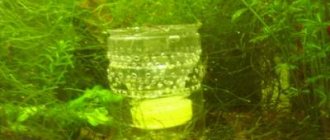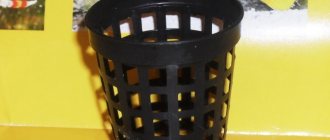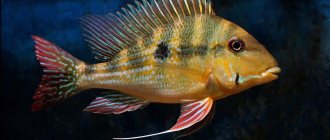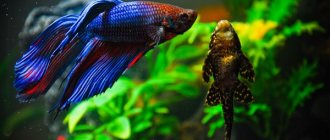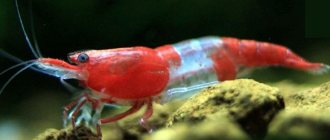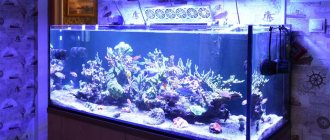Cherry shrimp are becoming increasingly popular among aquarists. They are unpretentious and undemanding in care, reproduce easily, are quite calm and tenacious. And when kept with other fish, you can feed cherry shrimp with any food, since they are practically omnivorous. At the same time, cherries can decorate any aquarium with their bright appearance.
Cherry shrimp are unpretentious and easy to care for
Motherland
Red Cherry Shrimp, or cherry shrimp, are the most colorful and popular representatives of crustaceans found in aquariums. The wild ancestors of this species are no different. They have a very inconspicuous appearance and gray color.
This type of shrimp is native to Asian countries (China, Korea, Japan, Taiwan). Habitat: mountain rivers, with slow and medium flows, waterfalls and bends. Crustaceans also like to settle in streams and clean reservoirs without excessive vegetation. Usually at the bottom of such reservoirs there is a layer of fallen leaves, which reduces the acid-base balance and stops the development of fungal and bacterial infections.
Through the efforts of breeders, red cherries acquired a red color, which, unfortunately, can manifest itself in different ways, from pale to fiery.
A group of breeders, by crossing the brightest individuals and careful selection, in two years bred a special species with a bright red color, which was called cherry. In nature, this type of shrimp is distinguished by the complete absence of bright pigments. There may be several bright stripes on the shell.
Now cherry shrimp have spread beyond their natural habitat. They easily displace native flora because they are prolific and tolerant of poor water quality. The cause is the unintentional spread of crustaceans by irresponsible aquarists.
Care and maintenance
These crustaceans are very prolific and hardy. Even a beginner can handle keeping this type of crustacean. But it is better to have not just one individual, but a flock of 5 to 10. In such a small group, the cherries will feel more comfortable.
Favorable conditions
- The temperature at which cherries can exist ranges from +4 to + 30 С. But at too high temperatures, metabolic processes in the shrimp’s body accelerate, and the crustaceans die very quickly. In optimal aquarium conditions, cherries live up to two years. Despite their unpretentiousness, crustaceans do not like sudden changes in temperature and other water parameters. In a stressful situation, cherries lose their bright color and reduce activity.
- Cherry shrimp reproduce very quickly. Their numbers can increase over a short period of time. Cherries crowd out other types of crustaceans that live in the same container.
- This type of krill is particularly sensitive to copper, which may be contained in some fish preparations.
- If a large population of shrimp lives in a reservoir, then waste must be removed periodically. This problem can be solved with the help of plants that partially recycle this waste and a siphon for cleaning the bottom.
- Shrimp are highly sensitive to ammonia. Its concentration can be monitored using tests, or you can choose a larger container.
- Impurities of nitrogen and compounds of this substance are undesirable in water.
Water parameters
| Volume per individual | Comfortable temperature | Acidity | Rigidity | Carbonate hardness |
| 1l | +21-24 Co | 7,5-7,8 | 6-8 | 2-5 |
Among the plants that are suitable for shrimp, special attention should be paid to Java moss, Riccia floating, Lomariopsis and Cladophora globulus.
At the moment when the crustacean is going through the molting period, it is especially vulnerable and defenseless. To create shelters, just place small ceramic tubes on the bottom.
Feeding the shrimp
Crustaceans in natural conditions act as scavengers. Their diet consists of algae, rotted leaves, and dead fish. In an aquarium, cherries need to be fed so that they eat everything completely in 5 or 10 minutes.
Feeding is a great opportunity to get a good look at your little secretive pets.
Food for cherry tomatoes can be vegetable porridge with a small amount of additives. You can feed fish food containing animal proteins.
It is important to give the shrimp Astaxatin. It is obtained from a certain type of algae and/or yeast. This substance allows you to preserve the bright color of cherries.
For a full-fledged existence, shrimp need to add spirulina to their food. This algae contains trace elements, vitamins and protein of plant origin. All this helps strengthen the immune system and prevent a large number of diseases.
Crustaceans can be fed not only with shrimp food, but also with carrots, dandelion leaves, cucumbers, zucchini, and nettles. In this case, it is necessary to scald the food with boiling water before serving.
Particular attention should be paid to live food. Cherries are very fond of tubifex and aulophoruses. But if crustaceans live together with fish, then this food should be given in a separate area, or placed inside the moss. Otherwise, the fish will eat the shrimp.
After molting, an exoskeleton remains in the aquarium. It cannot be removed; crustaceans use it to replenish the body’s need for minerals.
Before adding shrimp, any aquarium you choose must be equipped with a lid, mesh or cover glass with holes for air circulation
Shrimp very often jump out and run out of the pond. To avoid such problems, you should carefully seal all possible holes and cover the aqua with a lid.
Constancy of the environment
Despite their relative unpretentiousness, cherries are fragile creatures, and a sudden change in conditions is destructive for them. Therefore, in a shrimp tank (especially if it is small - 20-30 l) the following are unacceptable:
- massive water changes - more than 20%;
- uncontrolled supply of carbon dioxide, which can reduce acidity levels;
- simultaneous settlement of a large number of new inhabitants;
- overfeeding of hydrobionts.
Setting up a shrimp tank
Cherries are quite unpretentious in maintenance; they are content with small volumes. As an example: in my conditions, about a hundred individuals feel great, live and reproduce in a 20-liter shrimp tank. The aquarium is densely planted and there is no filter. Once a week I change 50% of the water. With such a dense population, it is pleasant to watch them - something is always happening. They feel comfortable if there are thickets of Java moss in the aquarium and an abundance of plants floating on the surface. The optimal water temperature is 20-26 degrees. Withstands a range from 15 to 30 degrees.
Cherries and seaweed
There is a lot of debate about the destruction of algae (beards, threads) by cherries. The opinions are diametrically opposed. My observations have shown that even if cherries eat algae, they do so very reluctantly. BUT! After I introduced the shrimp into the aquariums, the threadworm, which I had been constantly fighting for years, disappeared. Disappeared completely like a class! This is despite the fact that my cherries receive adequate nutrition and I don’t starve. I will make an assumption based on the observation that the algae disappeared not at all due to shrimp eating it.
For normal growth of algae, they need several conditions, including relative rest. That is, “they don’t like to be disturbed.” And the shrimp are constantly trampling on them! They are like chickens, which, if released into a garden, in a week will turn it into a compacted area, without a single blade of grass. Or the same football players will trample the football field if they don’t take care of it. Likewise, shrimp simply “trample down” algae, preventing them from growing and developing.
The other side of the coin is that many aquarists who have received my cherries claim that in their conditions they feed on algae. I do not deny.
Compatibility
Cherries do not show aggression towards other inhabitants of the aquarium. At the same time, crustaceans do not have the opportunity to give a worthy rebuff to their offenders. Very often, if there are no good hiding places in the aquarium, and there are fish that can swallow the cherry, the shrimp turn into live food.
Shrimp get along better with small fish.
It is recommended to use clown fish, gourami, neon (red and blue subspecies) and killi fish as neighbors. However, if there are crustacean fry in the aquarium, then any fish will pose a danger to the kids. You can create a separate corner for crustaceans, and separate it with a large piece of driftwood.
Together with cherry shrimp, it is possible to keep tiger shrimp in the same reservoir. Shrimp can interbreed with some types of crustaceans.
Description
Aquarium cherries reach a length of 2-4 cm. They have a bright color, so they stand out against the background of greenery in the aquarium. The lifespan of a crustacean is 1 year. During this year, females produce a large number of offspring.
In nature, cherry tomatoes rarely live a year and can die at birth because they become a source of food for fish. In an aquarium, the risk of being eaten is even higher, so experts recommend keeping cherry tomatoes separately from other aquatic inhabitants so that they do not die.
Diseases
Crustaceans are disease resistant. If the shrimp still gets sick, then most likely it will not be possible to cure it.
Sometimes cases arise when crustaceans themselves do not get sick, but are carriers of various fish diseases. If the aquarium contains fish and krill, then it is crustaceans that can cause infection. It is better to keep valuable fish in a separate reservoir.
Crustaceans most often suffer from parasites that occupy the shell, gills, muscle tissue and heart. Shrimp often die from fungal infections.
To avoid problems, new individuals must be kept in quarantine for 1 - 2 weeks.
Reproduction
Gender differences
First of all, you should learn to determine the sex of an individual. Females have a kind of “saddle”. This is a small light spot that is located on the back of the head. In addition, females are distinguished by their massiveness and larger abdominal cavity, since this is where the pockets for gestation of eggs are located. A boy in adulthood reaches 2 cm, and a girl – 3.5 cm. The male is more active and his abdominal cavity is quite thin. It is also worth noting that the shell of females always has greater color saturation.
The green tint of the saddle indicates that the cherry was bred from wild representatives. The yellower the saddle, the more cultured the crustacean's genes.
Reproduction process
The eggs begin to develop in the female’s “saddle”. At the moment when she is fully mature, the female begins to secrete pheromones that attract males. After mating, the female receives a sperm packet through which the eggs pass and fertilization occurs. After the eggs are released, the shrimp places them under the abdominal cavity. If the female shakes up the eggs, this is normal. This is done for better development of embryos.
Sometimes young and inexperienced females can shed their eggs. This is possible in stressful situations, as well as in cases where the cherries do not feel safe.
05:04
Cherry shrimp, cherry shrimp, reproduction, maintenance, feeding and compatibility with fish in the aquarium.
The number of eggs can vary from 20 to 30 and depends on the age of the female. The development period of the embryo depends on temperature conditions and can range from 14 to 21 days. Newborn specimens reach a size of 1 mm, and their shape does not differ from adult shrimp. The fry are almost completely absent of color for the purpose of self-defense.
Cherry breeding
The breeding process is simple. Since cherries are invertebrates, they reproduce easily without human intervention. It is enough to put males and females in one aquarium.
Shrimp differ in color, size and behavior. Females are large with a rounded abdominal line. They are much brighter than males. Males are pale, small and more active. Females that reach the age of 2-3 months develop a saddle in which they carry eggs.
Cherry shrimp reproduce easily without human intervention
After molting, the female releases pheromones into the water, thereby indicating that she is ready to mate. The males, having smelled the scent, look for a female, and then a short mating occurs. And after fertilization, they move the eggs to the saddle.
The female usually bears about 20-30 eggs for 2-3 weeks. During this period, the aquarium must be kept clean.
The eggs can be yellow or greenish in color, but as they grow they darken. Shrimp are born tiny (about 1 mm), but similar to their parents. At first, they hide among plants and feed on the same things as adults.
Due to the fact that cherry tomatoes are bred by artificial selection, if they are bred uncontrolled, their color will tend to return to natural, that is, transparent. Therefore, when cherry shrimp reproduce, only the brightest individuals mate. They also cross not brothers and sisters, but new cherries brought from other places.
Popular types
Red cherry includes several varieties that have significant differences in color. Some species have yellow, brown, orange and black colors.
Classes of red shrimp according to the color saturation of the shell:
Red Cherry
The lowest grade of red shrimp are transparent crustaceans with a certain number of red spots on the shell. They are called cherry or cherry.
Sakura
The sakura shrimp has a rich red color, but sometimes there are spots without pigment on the shell.
Fire red
Fire red cherry is distinguished by its vibrant red color.
Bright fiery red cherry
The most expensive and valuable class of shrimp is called the bright fiery red cherry. The body of the crustacean is distinguished by the rich dark color of its shell. These shrimp even have red legs. Shrimps of this class do not have areas without pigment on their body.
Yellow
Yellow shrimp. This species is sometimes called the "canary".
Red crystal
This species was bred through inbreeding. Representatives of crystals have weak immunity.
Harlequins
A dwarf subspecies with a white and red color.
Riley
A species resulting from mutation. Differ in a variety of shades.
Red Nose
Large subspecies, reaching 4 cm.
Cherry shrimp can mimic decorations. In order for the color to remain bright, it is worth choosing a dark type of soil for the aquarium. The color also depends to a large extent on the food. For a bright and rich color, it is worth giving frozen and live food to crustaceans. There are also drugs that can enhance the color of the shell; they are added to the food.
Caring for shrimp is not particularly difficult. In favorable conditions, cherries reproduce well and organize an entire colony. Females are constantly in a state of pregnancy. This is a great indicator that everything is fine with the cherries. Cherry shrimp are ideal for those just starting out in aquarium farming.
How to transport cherry tomatoes
When moving into a new house, cherries experience a lot of stress. The transportation process must be slow and careful (at least 60 minutes). To do this you need:
- Place the bag of arthropods in the tank to equalize the temperature.
- Add water from their new home to the bag in small portions.
- Then gradually release the cherry tomatoes into the aquarium.
During transportation, the bag must contain a plant with small leaves or moss. This will prevent injury to the shrimp during shaking.
As soon as the Malacostraca get into the new tank, they will actively move around the entire home in panic. After 30 minutes they will swim into the shelters of shells, plants, and pebbles. They will stay there for up to 3 days.
At this time, the cherry tomatoes will shed due to a stressful situation and new living conditions. Until the shell hardens, the arthropods will not leave their shelter. And then the cherries will again carelessly scurry around the entire tank.
In case of quarantine
If there are shrimp in the house, then new neighbors must be added after quarantine.
Temporary isolation of cherries should not take place in an empty tank. You need to place living vegetation, shelters (snags, tubes), and substrate in it.
It should be remembered that after isolation the shrimp will again be in a state of stress (when moved to a common reservoir). Accordingly, molting will begin, the females will shed their eggs. Consequently, in the absence of other varieties of shrimp and the reliability of the supplier of new individuals, you can immediately place the new settlers in a common tank.
Reviews
When an overpopulation of shrimp occurs in an aquarium, they jump out of the reservoir. This occurs in cases where approximately 100 or more individuals live in a 20-liter container. To control the population, I introduce fish that eat extra shrimp. If there are buyers for krill, or individuals with a particularly rich shell color appear, I move them into a separate container. Alexander, 33 years old, Samara
If you do not monitor the shrimp population, you may end up with shrimp without pigment in their shells. They fill the aquarium like cockroaches. From beautiful and colorful representatives of the cherry genus, shrimp turn into colorless creatures. I always select the most beautiful specimens from the young for posterity, and give the rest away, or take them to a pet store and drain them. Marina, 28 years old, Moscow region.
The aquarium is home to crustaceans, algae and fish, so I don’t worry about feeding the shrimp. They feed on fish scraps, algae, and waste. It's like a waste processing plant. You can sometimes sprinkle shrimp food. If everything is fine with the shrimp, they gather in a school. Hungry and dissatisfied people hide in secluded places. I watch the behavior of krill with interest. Even with regular feeding, I do one day a week as a fasting day. Alexey, 42, Astrakhan
What do aquarium shrimp eat?
Under natural conditions, these organisms are omnivores: they feed on dead algae, fallen leaves, microorganisms and almost all organic material that falls into the water. Food for aquarium shrimp could be just as unpretentious and varied if some of its species did not pollute the water. The diet depends on the living conditions of the shrimp:
- Mono aquarium. If invertebrates of one or more species live without fish, then they need an additional portion of fortified food. The main food products are algae and bloodworms.
- In the same container with fish. In such an eco-environment, the shrimp becomes an orderly, picking up food that the fish have not eaten. She feasts on algae on the glass, performing the function of a cleaner, but she can also eat dead fish.
